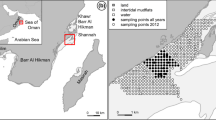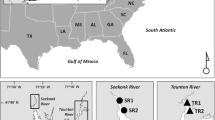Abstract
Larval and post-larval crab distribution was surveyed in three different habitats in Kachemak Bay, Alaska to determine temporal and spatial variability. Distribution varied temporally and spatially from June 2005 to September 2006. Nine sites of varying habitat complexity were surveyed monthly using scuba surveys and light traps to measure habitat variables and quantify crab zoeae and megalopae. A total of 10,016 crabs belonging to seven families were identified. Four species comprised the majority (97%) of the total crab assemblages and included Cancer oregonensis, Fabia subquadrata, Telmessus cheiragonus, and Pugettia gracilis. Peak abundances occurred in summer but varied on small temporal scales with species. No single bay-wide variable determined the appearance of all species. Depending on species, appearance may be influenced by seasonality of environmental variables. Spatially, highest abundances occurred in habitats with less structural complexity. Spatial differences in crab abundance may have resulted from variability on large scale physical transport mechanisms and not kelp-mediated flow alterations.




Similar content being viewed by others
References
Adams AE (1979) The life history of the snow crab, Chionoecetes opilio: a literature review. Alaska Sea Grant Program 78–13
Baird S, Pegau WS (2006) Water flow into Kachemak Bay: Is it isolated? EOS Trans Am Geophys Union 87(36), Ocean Sci Meet Suppl Abstract OS35P-22
DeBrosse GA, Baldinger AJ, McLaughlin PA (1989) A comparative study of the megalopal stages of Cancer oregonensis (Dana) and C. productus Randall (Decapoda: Brachyura: Cancridae) from the Northeastern Pacific. Fish Bull 88:39–49
Duggins DO, Eckman JE, Sewell AT (1990) Ecology of understory kelp environments. II. Effects of kelps on recruitment of benthic invertebrates. J Exp Mar Biol Ecol 143:27–45
Eckman JE, Duggins DO, Sewell AT (1989) Ecology of understory kelp environments. I. Effects of kelps on flow and particle transport near the bottom. J Exp Mar Biol Ecol 129:173–187
Eckman JE, Duggins DO, Siddon CE (2003) Current and wave dynamics in the shallow subtidal: implications to the ecology of understory and surface-canopy kelps. Mar Ecol Prog Ser 265:45–56
Field JG, Clarke KR, Warwick RM (1982) A practical strategy for analyzing multi-species distribution patterns. Mar Ecol Prog Ser 8:37–52
Fisher JL (2006) Seasonal timing and duration of brachyuran larvae in a high-latitude fjord. Mar Ecol Prog Ser 323:213–222
Foster MS, Schiel DR (1985) The ecology of giant kelp forests in California: a community profile. US Fish and Wildlife Service Biol Rep 85:152
Gaines SD, Roughgarden J (1987) Fish in offshore kelp forests affect recruitment to intertidal barnacle populations. Science 235:479–481
Gaylord B, Rosman JH, Koseff JR, Reed DC, Largier JL, McDonald C, MacIntyre S, Monismith SG, Brzezinski MA, Arkema K, Raimondi PT, Mardain B (2006) Spatial patterns of flow in and around giant kelp forests: kelp beds as permeable filters of nearshore water. EOS Trans Am Geophys Union 87(36), Ocean Sci Meet Suppl Abstract OS12E-02
Gaylord B, Rosman JH, Reed DC, Koseff JR, Fram J, MacIntyre S, Arkema K, McDonald C, Brzezinski MA, Largier JL, Monismith SG, Raimondi PT, Mardain B (2007) Spatial patterns of flow and their modification within and around a giant kelp forest. Limnol Oceanogr 52:1838–1852
Hamilton J, Konar B (2007) Implications of substrate complexity and kelp variability for south-central Alaskan nearshore fish communities. Fish Bull 105:189–196
Hart JFL (1935) The larval development of British Columbia Brachyura. Can J Res 12:412–431
Hart JFL (1960) The larval development of British Columbia. II. Majidae, subfamily Orenoiinae. Can J Zool 38:539–545
Haynes E (1981) Description of stage-I zoea of snow crab, Chionoecetes bairdi, (Oxyrhyncha, Majidae) from the plankton of lower Cook inlet, Alaska. Fish Bull 79:177–182
Herter HL (2006) Transport of Dungeness crab (Cancer magister) megalopae into Glacier Bay, Alaska. MSc Thesis. University of Alaska Fairbanks, Fairbanks, Alaska
Hines AH (1982) Coexistence in a kelp forest: size, population dynamics, and resource partitioning in a guild of spider crabs (Brachyura, Majidae). Ecol Monogr 52(2):179–198
Hurd CL, Stevens CL (1997) Flow visualization around single- and multiple-bladed seaweeds with various morphologies. J Phycol 33:360–367
Jackson GA (1984) Internal wave attenuation by coastal kelp stands. J Phys Oceanogr 14:1300–1306
Jackson GA (1986) Interaction of physical and biological processes in the settlement of planktonic larvae. Bull Mar Sci 39:202–212
Jackson GA, Winant CD (1983) Effects of a kelp forest on coastal currents. Cont Shelf Res 2:75–80
Jensen, GC (1995) Pacific Coast Crabs and Shrimps. Sea Challengers Baja, California, pp 1–87
Johnson J, Shanks AL (2002) Time series of the abundance of the post-larvae of the crabs Cancer magister and Cancer spp. on the southern Oregon coast and their cross-shelf transport. Estuaries 25:1138–1142
Ko HS (1998) Zoeal development of three species of Pugettia (Decapoda: Majidae), with a key to the known zoeas of the subfamily Epialtinae. J Crust Biol 18:499–510
Koehl MAR, Wainwright SA (1977) Mechanical adaptations of a giant kelp. Limnol Oceanogr 22:1067–1071
Kornieko ES, Korn OM (2004) Morphological features of the larvae of spider crab Pugettia quadridens (Decapoda: Majidae) from the northwestern Sea of Japan. Russ J Mar Biol/Biol Morya 30:402–413
Lough RG (1974) Dynamics of crab larvae (Anomura, Brachyura) off the central Oregon coast. PhD, Oregon State University
Mace AJ, Morgan SG (2006) Biological and physical coupling in the lee of a small headland: contrasting transport mechanisms for crab larvae in an upwelling region. Mar Ecol Prog Ser 324:185–196
McLaughlin PA, Camp DK, Angel MV, Bousfield EL, Brunel P, Brusca RC, Cadien D, Cohen AC, Conlan K, Eldredge LG, Felder DL, Goy JW, Haney T et al. (2005) Common and scientific names of aquatic invertebrates in the United States and Canada: Crustaceans. Am Fish Soc Spec Publ 31, 545 pp
Miller JA, Shanks AL (2004) Ocean-estuary coupling in the Oregon upwelling region: abundance and transport of juvenile fish and of crab megalope. Mar Ecol Prog Ser 271:267–279
Morgan SG (1987) Adaptive significance of hatching rhythms and dispersal patterns of estuarine crab larvae: avoidance of physiological stress by larval export? J Exp Mar Biol Ecol 113:71–78
Morgan SG (1989) Adaptive significance of spination in estuarine crab zoeae. Ecology 70:464–482
Morgan SG (1995) The timing of larval release. In: McEdward LR (ed) Ecology of marine invertebrate larvae. CRC, Boca Raton, pp 157–191
Norderhaug KM, Christie H, Fossa JH, Fredriksen S (2005) Fish-macrofauna interactions in a kelp (Laminaria hyperborea) forest. J Mar Biolog Assoc U.K 85:1279–1286
Park W, Shirley TC (2005) Diel vertical migration and seasonal timing of the larvae of three sympatric cancrid crabs, Cancer spp., in southeastern Alaska. Estuaries 28:266–273
Park W, Douglas DC, Shirley TC (2007) North to Alaska: evidence for conveyor belt transport of Dungeness crab larvae along the west coast of the United States and Canada. Limnol Oceanogr 52(1):248–256
Paula J, Dray T, Queiroga H (2001) Interaction of offshore and inshore processes controlling settlement of brachyuran megalope in Saco mangrove creek, Inhaca Island (South Mozambique). Mar Ecol Prog Ser 215:251–260
Polis GA, Strong DR (1996) Food web complexity and community dynamics. Am Nat 147:813–846
Queiroga H, Blanton J (2005) Interactions between behavior and physical forcing in the control of horizontal transport of decapod crustacean larvae. In: Southward AJ, Tyler PA, Young CM, Fuiman LA (eds) Advances in marine biology, vol 4. Elsevier Academic, San Diego, pp 118–169
Quijon PA, Snelgrove PVR (2005) Spatial linkages between decapod planktonic and benthic adult stages in a Newfoundland fjordic system. J Mar Res 63:841–862
Reyns N, Sponaugle S (1999) Patterns and processes of brachyuran crab settlement to Caribbean coral reefs. Mar Ecol Prog Ser 185:155–170
Roegner GC, Armstrong DA, Hickey BM, Shanks AL (2003) Ocean distribution of Dungeness crab megalope and recruitment patterns to estuaries in southern Washington State. Estuaries 26(4B):1058–1070
Rosman JH, Koseff JR, Monismith SG, Grover J (2007) A field investigation into the effects of a kelp forest (Macrocystis pyrifera) on coastal hydrodynamics and eransport. J Geophys Res (C Oceans) 112:1–16
Roughgarden J, Gaines S, Possingham H (1988) Recruitment dynamics in complex life cycles. Science 241:1460–1466
Shanks AL (1995a) Mechanisms of cross-shelf dispersal of larval invertebrates and fish. In: McEdward LR (ed) Ecology of marine invertebrate larvae. CRC, Boca Raton, pp 324–367
Shanks AL (1995b) Oriented swimming by megalope of several eastern North Pacific crab species and its potential role in their onshore migration. J Exp Mar Biol Ecol 186:1–16
Shanks AL (2001) An identification guide to the larval marine invertebrates of the Pacific Northwest. Oregon State University Press, Corvalis, pp 179–250
Shirley S, Shirley T (1989) Interannual variability in density, timing and survival of Alaskan red king crab Paralithodes camtschatica larvae. Mar Ecol Prog Ser 54:51–59
Starr M, Himmelman J, Therriault J (1990) Direct coupling of marine invertebrate spawning with phytoplankton blooms. Science 247:1071–1074
Sulkin SD, McKeen G (1994) Influence of temperature on larval development of four co-occurring species of the brachyuran genus Cancer. Mar Biol 118:593–600
Trainor K, Church M (2003) Quantifying variability in stream channel morphology. Water Resour Res 39(9):1248
Ueda Y, Takayanagi S, Utoh H, Yorita T (1999) Appearance period of larvae of Erimacrus isenbeckii and Telmesus spp. in adjacent waters of Funka Bay, Hokkaido. Sci Rep Hokkaido Fish Exp Stn 55:97–103
Wolanski E, Hamner WM (1988) Topographically controlled fronts in the ocean and their biological influence. Science 241:177–181
Acknowledgments
We thank T. Shirley and G. Eckert for reviews on this manuscript, J. Markis for help in the field, M. and C. Geagle at the Kasitnsa Bay Lab for logistical support, S. Pegau, S. Evans, N. Harman, E. Daly, and C. Debenham for additional field support. We also thank the National Estuarine Research Reserve (NERR) System and the Pollock Conservation Cooperative Research Center (PCCRC) for their financial support.
Author information
Authors and Affiliations
Corresponding author
Additional information
Communicated by R. Cattaneo-Vietti.
Rights and permissions
About this article
Cite this article
Daly, B., Konar, B. Effects of macroalgal structural complexity on nearshore larval and post-larval crab composition. Mar Biol 153, 1055–1064 (2008). https://doi.org/10.1007/s00227-007-0878-7
Received:
Accepted:
Published:
Issue Date:
DOI: https://doi.org/10.1007/s00227-007-0878-7




